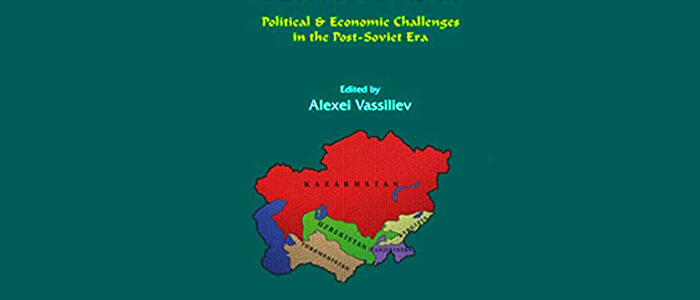First published in 2000, “Central Asia: Political and Economic Challenges in the Post-Soviet Era” is based on the primary research carried out by the Center for Civilisational and Regional Studies of the Russian Academy of Sciences. Compiled from different writings of various authors, Alexei Vassiliev has edited the book. It is organised into five parts, except the introduction, which covers Russia and Central Asia, and the conclusion section. This book is relevant even today to understand the current geopolitical and cultural ties of Central Asian Republics (CARs) with Russia, embedded in history.
The collection of essays addresses issues that emerged as a result of the dissolution of the Soviet Union and the formation of new states of Kazakhstan, Uzbekistan, Turkmenistan, Tajikistan, and Kyrgyzstan. These countries had a shaky relationship with Russia initially. The book is written eloquently and points out each state’s political challenges. The author(s) explain how these states framed their constitutions to keep their unique and sovereign identities in accordance with the preferences of their citizens to avoid further squabbles. The language was one of the most difficult problems that the newly formed states had to deal with. But the local political leaders and constitution drafters were able to resolve it.
This book identifies the fault lines between the countries in the region, particularly Kazakhstan and Uzbekistan. The changes implemented by the individual administrations are also discussed. The author(s) write about the foreign policies of these states, including their approach to coping with the economic crises, which included welcoming foreign investors through the signing of numerous agreements with various countries. The book also examines the course of economic growth in the 1990s, namely the recession of 1991–1995 and the growing wealth discrepancy between the affluent minority and the destitute majority during that time. Turkey and Iran, the kin of the Central Asians, have proven to be too lethargic in terms of economic growth to provide assistance and serve as engines for the region’s development. The wealthy brothers in faith in the rich countries have been in no rush to share their wealth with the Central Asians. Still, the tigers in the West and Asia have prioritised investments in profitable businesses such as mining, metallurgy, telecommunications, and automobile assembly plants.
The geostrategic position of CARs, and the ramifications of this position, are emphasised by the author(s). The book suggests that initially, the majority of Central Asians over the age of 30 who were fluent in Russian were either naturally or intentionally drawn to the Russian Federation. The observation that was made almost twenty years ago is largely true even today as people still feel Russia as their nearest universe for work and jobs. The writer(s) also demonstrate the challenges for Russians worsened due to the ethnic policies followed by the local political leaders in the area. General degradation in the level of education and a preference for the clan and ethnic ties over knowledge and skills, which impacted Russians more than indigenous peoples, contributed to the situation. Every one of these issues continues to function as a catalyst for emigration, particularly among young people.
The potential routes for oil and natural gas transportation have been one of the region’s focal points of geopolitical conflict. Oil pipelines that cross through Azerbaijan, Georgia, and Turkey and avoid the territories of Russia and Iran have been clearly preferred by both the United States and western European countries. The possibility of supplying Turkmen gas via the same route or via Afghanistan is discussed in the book. The consequent Turkmenistan, Afghanistan, Pakistan and Indian gas pipeline, commonly known as TAPI, lurk for the past three decades. It has seen the geopolitical contestation among major countries and instability in Afghanistan. The book suggests that the efforts of the western countries and their big businesses are directed toward a significant deterioration of Russia’s position in Central Asia and its collaboration with the southern Commonwealth of Independent States (CIS).
Following my reading of this book, I am able to recognise the high quality of the writers’ work in the form of merits, which include the following: A comprehensive overview of Central Asia is offered in this book, which includes detailed information on the economic structure of each country’s economy as well as its relative position among the other CIS. The arguments of the author(s) are backed by the inclusion of several tables to assist the reader in understanding the economic structure, which is an excellent approach. The author’s use of quotations and references throughout the book demonstrates the genuineness of the author’s writing. Central Asian countries’ political systems and their early obstacles are just a few examples of the wealth of knowledge available on the subject of constitutional disputes covered in the book.
There are certain weaknesses to this compilation, as well. I feel compelled to point out the following flaws. The author(s) employed an excessive number of tables to support a state’s economy; however, it does not explain the causes of any economic failure. Besides, the difficulties that the newly formed states encountered were not related to Islam. However, it was believed that these states would adopt Islam as their national identity, but their adoption of secularism contradicts this premise. The politicisation of Islam in the CARs is a topic that was barely touched upon in this book.
It is crucial to note that this book is an excellent resource for students of Central Asian economics and politics, business professionals, and other readers interested in the growth of post-Soviet governments in general. This compilation continues to be of particular interest to researchers, members of the academic community, and members of the think tank industry.
